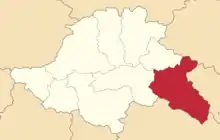Signakh uezd
The Signakh uezd[lower-alpha 1] was a county (uezd) of the Tiflis Governorate of the Caucasus Viceroyalty of the Russian Empire, and then of Democratic Republic of Georgia, with its administrative centre in Signakh (present-day Signagi).[1] The area of the county roughly corresponded to the contemporary Kakheti region of Georgia.
Signakh uezd
Сигнахскій уѣздъ | |
|---|---|
 Coat of arms | |
 Location in the Tiflis Governorate | |
| Country | Russian Empire |
| Viceroyalty | Caucasus |
| Governorate | Tiflis |
| Established | 1801 |
| Abolished | 1929 |
| Capital | Signakh (present-day Signagi) |
| Area | |
| • Total | 6,022.39 km2 (2,325.26 sq mi) |
| Population (1916) | |
| • Total | 153,864 |
| • Density | 26/km2 (66/sq mi) |
| • Urban | 11.48% |
| • Rural | 88.52% |
History
Following the Russian Revolution, the Signakh uezd was incorporated into the short-lived Democratic Republic of Georgia.[1]
Administrative divisions
The subcounties (uchastoks) of the Signakh uezd in 1913 were as follows:[2]
| Name | 1912 population | Area |
|---|---|---|
| Bakurtsikhskiy uchastok (Бакурцихскій участокъ) | 23,881 | 1,170.96 square versts (1,332.63 km2; 514.53 sq mi) |
| Kodalskiy uchastok (Кодальскій участокъ) | 50,638 | 1,205.14 square versts (1,371.52 km2; 529.55 sq mi) |
| Nizhne-Machkhaanskiy uchastok (Нижне-Мачхаанскій участокъ) | 53,588 | 733.29 square versts (834.53 km2; 322.21 sq mi) |
| Shirakskiy uchastok (Ширакскій участокъ) | 6,222 | 2,182.40 square versts (2,483.71 km2; 958.96 sq mi) |
| Zaalazanskiy raion (Заалазанскій раіонъ) | 12,645 | – |
Demographics
Russian Empire Census
According to the Russian Empire Census, the Signakh uezd had a population of 102,313 on 28 January [O.S. 15 January] 1897, including 55,958 men and 46,355 women. The majority of the population indicated Georgian to be their mother tongue, with significant Armenian and Tatar[lower-alpha 2] speaking minorities.[5]
| Language | Native speakers | % |
|---|---|---|
| Georgian | 84,827 | 82.91 |
| Armenian | 6,392 | 6.25 |
| Tatar[lower-alpha 2] | 5,272 | 5.15 |
| Russian | 4,413 | 4.31 |
| Ukrainian | 447 | 0.44 |
| Avar-Andean | 279 | 0.27 |
| Lithuanian | 187 | 0.18 |
| Polish | 126 | 0.12 |
| Jewish | 108 | 0.11 |
| Belarusian | 50 | 0.05 |
| German | 44 | 0.04 |
| Imeretian | 39 | 0.04 |
| Ossetian | 30 | 0.03 |
| Czech | 12 | 0.01 |
| Persian | 11 | 0.01 |
| Kazi-Kumukh | 10 | 0.01 |
| Greek | 8 | 0.01 |
| Mingrelian | 8 | 0.01 |
| Latvian | 6 | 0.01 |
| Dargin | 4 | 0.00 |
| Italian | 1 | 0.00 |
| Kist | 1 | 0.00 |
| Kyurin | 1 | 0.00 |
| Other | 37 | 0.04 |
| TOTAL | 102,313 | 100.00 |
Kavkazskiy kalendar
According to the 1917 publication of Kavkazskiy kalendar, the Signakh uezd had a population of 153,864 on 14 January [O.S. 1 January] 1916, including 80,670 men and 73,194 women, 148,646 of whom were the permanent population, and 5,218 were temporary residents:[6]
| Nationality | Urban | Rural | TOTAL | |||
|---|---|---|---|---|---|---|
| Number | % | Number | % | Number | % | |
| Georgians | 8,493 | 48.09 | 109,790 | 80.61 | 118,283 | 76.88 |
| Armenians | 8,970 | 50.79 | 6,038 | 4.43 | 15,008 | 9.75 |
| Russians | 179 | 1.01 | 11,500 | 8.44 | 11,679 | 7.59 |
| Shia Muslims[lower-alpha 3] | 0 | 0.00 | 3,275 | 2.40 | 3,275 | 2.13 |
| Asiatic Christians | 0 | 0.00 | 3,201 | 2.35 | 3,201 | 2.08 |
| Sunni Muslims[lower-alpha 4] | 0 | 0.00 | 1,862 | 1.37 | 1,862 | 1.21 |
| Jews | 7 | 0.04 | 324 | 0.24 | 331 | 0.22 |
| North Caucasians | 0 | 0.00 | 210 | 0.15 | 210 | 0.14 |
| Other Europeans | 13 | 0.07 | 2 | 0.00 | 15 | 0.01 |
| TOTAL | 17,662 | 100.00 | 136,202 | 100.00 | 153,864 | 100.00 |
Notes
- Before 1918, Azerbaijanis were generally known as "Tatars". This term, employed by the Russians, referred to Turkic-speaking Muslims of the South Caucasus. After 1918, with the establishment of the Azerbaijan Democratic Republic and "especially during the Soviet era", the Tatar group identified itself as "Azerbaijani".[3][4]
- Primarily Tatars.[7]
- Primarily Turco-Tatars.[7]
References
- Tsutsiev 2014.
- Кавказский календарь на 1913 год, pp. 164–175.
- Bournoutian 2018, p. 35 (note 25).
- Tsutsiev 2014, p. 50.
- "Демоскоп Weekly - Приложение. Справочник статистических показателей". www.demoscope.ru. Retrieved 2022-06-30.
- Кавказский календарь на 1917 год, pp. 206–213.
- Hovannisian 1971, p. 67.
Bibliography
- Bournoutian, George A. (2018). Armenia and Imperial Decline: The Yerevan Province, 1900–1914. Milton Park, Abingdon, Oxon: Routledge. ISBN 978-1-351-06260-2. OCLC 1037283914.
- Hovannisian, Richard G. (1971). The Republic of Armenia: The First Year, 1918–1919. Vol. 1. Berkeley: University of California Press. ISBN 978-0520019843.
- Кавказский календарь на 1913 год [Caucasian calendar for 1913] (in Russian) (68th ed.). Tiflis: Tipografiya kantselyarii Ye.I.V. na Kavkaze, kazenny dom. 1913. Archived from the original on 19 April 2022.
- Кавказский календарь на 1917 год [Caucasian calendar for 1917] (in Russian) (72nd ed.). Tiflis: Tipografiya kantselyarii Ye.I.V. na Kavkaze, kazenny dom. 1917. Archived from the original on 4 November 2021.
- Tsutsiev, Arthur (2014). Atlas of the Ethno-Political History of the Caucasus (PDF). Translated by Nora Seligman Favorov. New Haven: Yale University Press. ISBN 9780300153088. Archived (PDF) from the original on 17 June 2023.